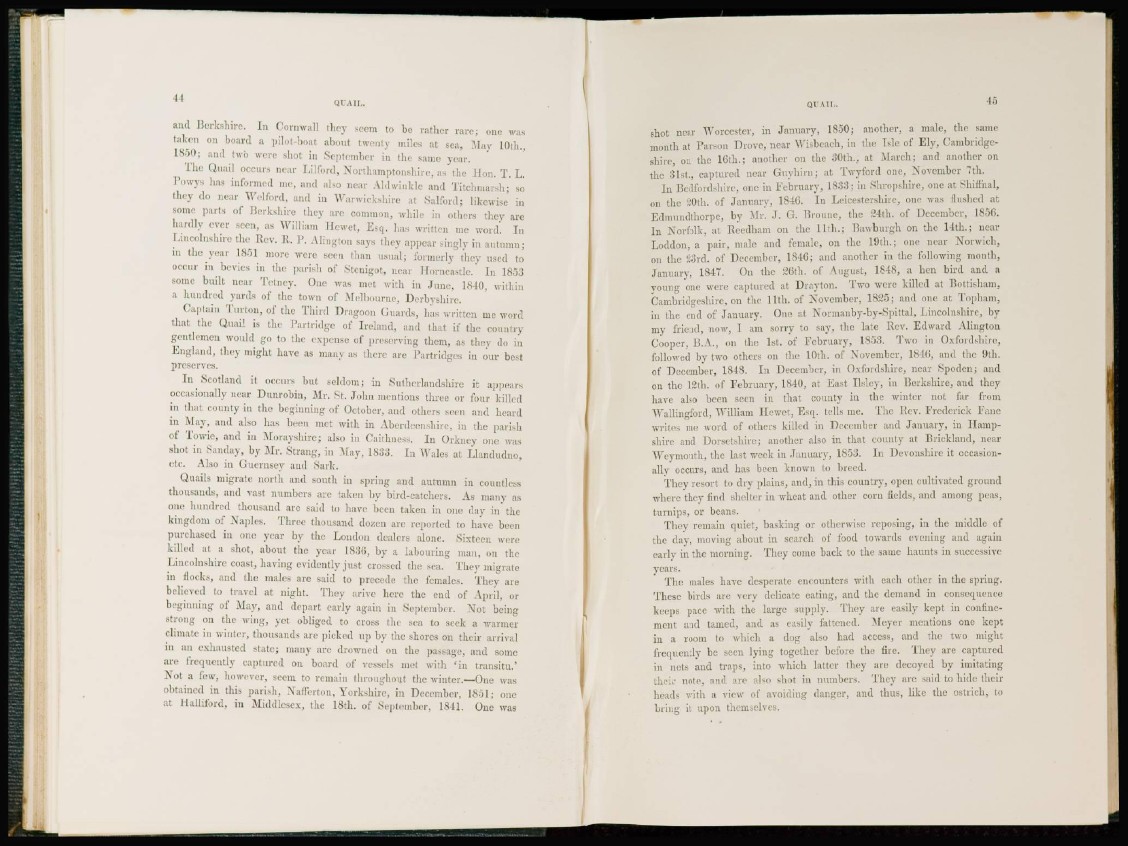
11 QTATJ,.
and Berkshire. In Cornwall they seem to be rather rare; one was
taken on board a pilot-boat about twenty miles at sea, May 10th.,
1850; and two were shot in September in the same year.
The Quail occurs near Lilford, Northamptonshire, as the Hon. T. L.
Powys lias informed mo, atul also near Aldwinkle and Titchmarsh; so
they do near Welford, and in Warwickshire at Salford; likewise in
some parts of Berkshire they are common, while in others they are
hardly ever seen, as William Hewet, Esq. lias -written me word. In
Lincolnshire the Rev. R. P. Alingtou says they appear singly in autumn;
in the year 1851 more were seen than usual; formerly they used to
occur in bevies in the parish of Stcuigot, near Horncastle. In 1858
some built near Tetucy. One was met with in June, 1840, within
a hundred yards of the town of Melbourne, Derbyshire.
Captain Turton, of the Third Dragoon Guards, has written me word
that the Quail is the Partridge of Ireland, and that if the country
gentlemen would go to the expense of preserving them, as they do in
England, they might have as many as there are Partridges in our best
preserves.
I n Scotland it occurs but seldom; in Sutherlandshire it appears
occasionally near Dunrobin, Mr. St. John mentions three or four killed
in that county in the beginning of October, and others seen and heard
in May, and also has been met with in Aberdeenshire, in the parish
of Towie, and in Morayshire; also in Caithness. In Orkney one was
shot in Sanday, by Mr. Strang, in May, 1833. In Wales at Llandudno,
etc. Also in Guernsey and Sark.
Quails migrate north and south in spring and autumn in countless
thousands, and vast numbers are taken by bird-catchers. As many as
one h u n d r e d thousand are said to have been taken in one day in the
kingdom of Naples. Three thousand dozen are reported to have been
purchased in one year by the London dealers alone. Sixteen were
killed at a shot, about the year 1830, b y a labouring man, on the
Lincolnshire coast, having evidently j u s t crossed the sea. They migrate
in Hocks, and the males are said to precede the females. They are
believed to travel at night. They arive here the end of April, or
beginning of May, and depart early again in September. Not being
strong on the wing, yet obliged to cross the sea to seek a warmer
climate in winter, thousands arc picked up by the shores on their arrival
in an exhausted -late; many are drowned on the passage, and some
arc frequently captured on board of vessels met with ' in transitu.*
Not a lew, however, seem to remain throughout the winter.—One was
obtained in this parish, Nafferton, Yorkshire, in December, 1851; one
at Haliiford, in Middlesex, the 18th. of September, 1841. One was
o r AIL. 15
shot near Worcester, in January, 1850; another, a male, the same
month at Parson Drove, near Wisbeach, in the Tsle of Ely, Cambridgeshire,
on the 16th.; another on the 30th., at March; and another on
the 31st., captured near G u y h i r n ; at Twyford one, November 7th.
I n Bedfordshire, one in February, 1833; in Shropshire, one at Shiffhal,
on the 20th. of January, 1846. In Leicestershire, one was flushed at
Edmundthorpe, by Mr. J. G. Brounc, the 24th. of December, 1856.
I n Norfolk, at Reedham on the 11th.; Bawburgh on the 14th.; near
Loddon, a pair, male and female, on the 19th.; one near Norwich,
on the 23rd. of December, 1846; and another in the following month,
January, 1847. On the 26th. of August, 1848, a hen bird and a
young one -were captured at Drayton. Two were killed at Bottisham,
Cambridgeshire, on the 11th. of November, 1825; and one at Topham,
in the end of January. One at Normanby-by-Spittal, Lincolnshire, by
my friend, now, I am sorry to say, the late llcv. Edward Alington
Cooper, B.A., on the 1st. of February, 1853. Two in Oxfordshire,
followed by two others on the 10th. of November, 1846, and the 9th.
of December, 1848. In December, in Oxfordshire, near Spoden; and
on the 12th. of February, 1840, at East Ilsley, in Berkshire, and they
have also been seen in that county in the winter not far from
Wallingibrd, William Hewet, Esq. tells me. The Rev. Frederick Fane
writes me word of others killed in December and January, in Hampshire
and Dorsetshire; another also in that county at Brickland, near
A\ eymouth, the last week in J a n u a r y , 1853. In Devonshire it occasionally
occurs, and has been known to breed.
They resort to dry plains, and, in this country, open cultivated ground
where they find shelter in wheat and other corn fields, and among peas,
turnips, or beans.
They remain quiet, basking or otherwise reposing, in the middle of
the day, moving about in search of food towards evening and again
early in the morning. They come back to the same haunts in successive
years.
The males have desperate encounters with each other in the spring.
These birds are very delicate eating, and the demand in consequence
keeps pace with the large supply. They are easily kept in confinement
and tamed, and as easily fattened. Meyer mentions one kept
in a room to which a dog also had access, and the two might
frequently be seen lying together before the fire. They arc captured
in nets and traps, into which latter they are decoyed by imitating
their note, and are also shot in numbers. They arc said to hide their
heads with a view of avoiding danger, and thus, like the ostrich, to
bring it upon themselves.